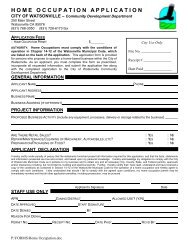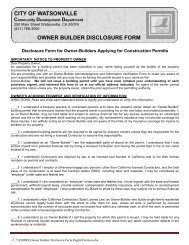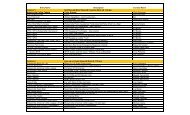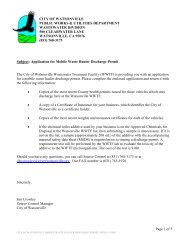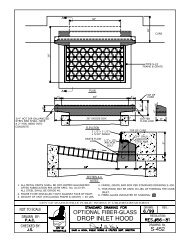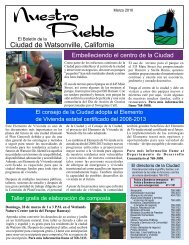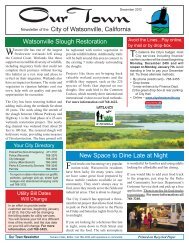Vegetation Management and Maintenance Plan - Watsonville ...
Vegetation Management and Maintenance Plan - Watsonville ...
Vegetation Management and Maintenance Plan - Watsonville ...
Create successful ePaper yourself
Turn your PDF publications into a flip-book with our unique Google optimized e-Paper software.
BOX ELDER<br />
Acer negundo<br />
DISTINCTIVE FEATURES This is a common deciduous tree along<br />
creeks <strong>and</strong> sloughs. The tree supports opposite compound leaves that<br />
hang from slender petioles (stems). Each leaf is pale green 2-4 inches<br />
long, <strong>and</strong> has three leaflets, each lobed with toothed margins. Winged<br />
seeds (samaras) form in late summer. Trees can reach 50 to 70 feet<br />
tall.<br />
BLOOMS Small, white, in drooping clusters, March - April.<br />
PREFERRED HABITAT along streams <strong>and</strong> edges of sloughs; also<br />
planted as large garden trees. Box elder trees were planted along upper<br />
Struve Slough.<br />
WESTERN SYCAMORE<br />
Platanus racemosa<br />
DESCRIPTION The statuesque tree is characterized by the white<br />
<strong>and</strong> gray jigsaw-like pattern to its bark <strong>and</strong> the multiple, twisting<br />
branches. The deciduous leaves are 5-10 inches wide, light green,<br />
deeply lobed, <strong>and</strong> when young have a velvety texture. Small clusters<br />
of flowers hang from the stems in spring, ripening into round, spiny<br />
fruits. Mature trees can reach up to 100 feet tall.<br />
BLOOMS Whitish in small clusters, March - April.<br />
PREFERRED HABITAT Upper edges of creeks <strong>and</strong> rivers where<br />
they are subject to infrequent flooding. Sycamores have been planted<br />
along upper Struve Slough.




